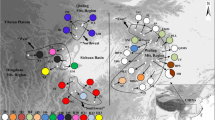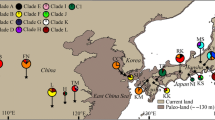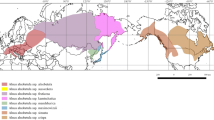Abstract
Neolitsea sericea is an evergreen broad leaved tree in the warm-temperate regions of East Asia. This area is a hotspot for plant species richness and endemism caused by dynamic changes in land configuration during the Quaternary. However, the historical migration of such evergreen tree species is still poorly understood. In an attempt to reconstruct the phylogeographic history of N. sericea during the Quaternary, we identified the chloroplast DNA haplotypes of 287 individuals from 33 populations covering almost all of its geographic range. Analyses were based on sequence data from the trnL–F, psbC–trnS, and rps16 regions. Nine haplotypes were identified. The majority included ancestral types in the southwestern part of the main islands of Japan, with other region-specific haplotypes being found in populations on the Korean Peninsula, Taiwan (Isl. Lanyu), and elsewhere in Japan. A statistical parsimony network revealed two lineages derived from Japanese main islands. One was represented on the Korean Peninsula, the other on Isl. Lanyu. The current distribution of N. sericea has been shaped by colonization via land bridges. During the glacial periods, two primary, but separate migration routes were followed—from the southwestern part of the Japanese main islands to either the Korean Peninsula or Taiwan. In addition, we believe the Zhoushan populations were shaped by post-glacial processes through an ECS land bridge (East China Sea basin) from northern refugia that existed during the late Pleistocene.


Similar content being viewed by others
References
Aoki K, Suzuki T, Hsu TW, Murakami N (2004) Phylogeography of the component species of broad-leaved evergreen forests in Japan, based on chloroplast DNA variation. J Plant Res 117:77–94
Aoki K, Matsumura T, Hattori T, Murakami N (2006) Chloroplast DNA phylogeography of Photinia glabra (Rosaceae) in Japan. Am J Bot 93:1852–1858
Avise JC (2000) Phylogeography: the history and formation of species. Harvard University Press, Cambridge
Bai WN, Liao WJ, Zhang DY (2010) Nuclear and chloroplast DNA phylogeography reveal two refuge areas with asymmetrical gene flow in a temperate walnut tree from East Asia. New Phytol 188:892–901
Chen KC, Pan FJ (1997) New findings on the genus Neolitsea (Lauraceae) in Taiwan (in Chinese with English summary). Taiwan J For Sci 12:155–166
Chen KM, Abbott RJ, Milne RI, Tian XM, Liu JQ (2008) Phylogeography of Pinus tabulaeformis Carr. (Pinaceae), a dominant species of coniferous forest in northern China. Mol Ecol 17:4276–4288
Cheng YP, Hwang SY, Lin TP (2005) Potential refugia in Taiwan revealed by the phylogeographical study of Castanopsis carlesii Hayata (Fagaceae). Mol Ecol 14:2075–2085
Chung MG, Chung MY, Oh GS, Epperson B (2000) Spatial genetic structure in a Neolitsea sericea population (Lauraceae). Heredity 85:490–497
Clement M, Posada D, Crandall KA (2000) TCS: a computer program to estimate gene genealogies. Mol Ecol 9:1657–1659
Corriveau JL, Coleman AW (1988) Rapid screening method to detect potential biparental inheritance of plastid DNA and results for over 200 angiosperm species. Am J Bot 75:1443–1458
Duminil J, Fineschi S, Hampe A, Jordano P, Salvini D, Vendramin GG, Petit RJ (2007) Can population genetic structure be predicted from life-history traits? Am Nat 169:662–672
Dupanloup I, Schneider S, Excoffier L (2002) A simulated annealing approach to define the genetic structure of populations. Mol Ecol 11:2571–2581
Excoffier L, Smouse PE, Quattro JM (1992) Analysis of molecular variance inferred from metric distances among DNA haplotypes: applications to human mitochondrial DNA restriction data. Genetics 131:479–491
Excoffier L, Laval G, Schneider S (2005) Arlequin (version 3.0): an integrated software package for population genetics data analysis. Evol Bioinform Online 1:47–50
Hampe A, Arroyo J, Jordano P, Petit RJ (2003) Rangewide phylogeography of a bird-dispersed Eurasian shrub: contrasting Mediterranean and temperate glacial refugia. Mol Ecol 12:3415–3426
Harrison SP, Yu G, Takahara H, Prentice IC (2001) Palaeovegetation: diversity of temperate plants in East Asia. Nature 413:129–130
Hatusima S (1969) On some species of the Lauraceae from Japan and Taiwan (in Japanese). J Geobot 17:106–107
Hayata B (1911) Materials for a flora of Formosa. Journal of the College of Science, Imperial University, Tokyo, Japan
Heuertz M, Fineschi S, Anzidei M, Pastorelli R, Salvini D, Paule L, Frascaria-Lacoste N, Hardy OJ, Vekemans X, Vendramin GG (2004) Chloroplast DNA variation and postglacial recolonization of common ash (Fraxinus excelsior L.) in Europe. Mol Ecol 13:3437–3452
Hewitt GM (1999) Post-glacial re-colonization of European biota. Biol J Linn Soc 68:87–112
Hewitt GM (2000) The genetic legacy of the Quaternary ice ages. Nature 405:907–913
Hewitt G (2003) Ice ages: species distributions, and evolution. In: Rothschild LJ, Lister AM (eds) Evolution on planet earth. Academic Press, Amsterdam
Hikida T, Ota H (1997) Biogeography of reptiles in the subtropical East Asian islands. In: Lue KY, Chen T-H (eds) Proceedings of the Symposium on the Phylogeny, Biogeography and Conservation of Fauna and Flora of East Asian Region. National Science Council, Taipei, pp 11–28
Hong SK, Nakagoshi N, Fu B, Morimoto Y (2007) Landscape ecological applications in man-influenced areas: linking man and nature systems. Springer, New York
Huang S, Chiang YC, Schaal BA, Chou CH, Chiang TY (2001) Organelle DNA phylogeography of Cycas taitungensis, a relict species in Taiwan. Mol Ecol 10:2669–2681
Huang SSF, Hwang SY, Lin TP (2002) Spatial pattern of chloroplast DNA variation of Cyclobalanopsis glauca in Taiwan and East Asia. Mol Ecol 11:2349–2358
Kimura M (1983) The neutral theory of molecular evolution. Cambridge University Press, Cambridge
Kimura M (1996) Quaternary paleogeography of the Ryukyu Arc (in Japanese with English summary). J Geogr 105:259–285
Kimura M (2000) Paleography of the Ryukyu Islands. Tropics 10:5–24
Kitamura A, Kimoto K (2006) History of the inflow of the warm Tsushima Current into the Sea of Japan between 3.5 and 0.8 Ma. Palaeogeogr Palaeoclimatol Palaeoecol 236:355–366
Kizaki K, Oshiro I (1977) Paleogeography of the Rytkyu [sic] Islands (in Japanese with English summary). Marine Sci Mon 9:543–547
Kominami Y, Sato T, Takeshita K, Manabe T, Endo A, Noma N (2003) Classification of bird-dispersed plants by fruiting phenology, fruit size, and growth form in a primary lucidophyllous forest: an analysis, with implications for the conservation of fruit-bird interactions. Ornithol Sci 2:3–23
Lee JH, Choi BH (2010) Distribution and northernmost limit on the Korean Peninsula of three evergreen trees (in Korean with English summary). Korean J Pl Taxon 40:267–273
Lee JH, Lee BY, Choi BH (2011) Preliminary search of intraspecific chloroplast DNA variation of nine evergreen broad leaved plants in East Asia. Korean J Pl Taxon 41:194–201
Li EX, Yi S, Qiu YX, Guo JT, Comes HP, Fu CX (2008) Phylogeography of two East Asian species in Croomia (Stemonaceae) inferred from chloroplast DNA and ISSR fingerprinting variation. Mol Phylogenet Evol 49:702–714
Liao JC (1996) Neolitsea Merr. In: Editorial Committee of the Flora of Taiwan (eds) Flora of Taiwan, vol 2. Tah Jinn Printing Company Ltd., Taipei, pp 484–496
Mantel N (1967) The detection of disease clustering and generalized regression approach. Cancer Res 27:209–220
Miyazaki T, Yamaguchi YY, Hoshino Y, Ohba H (2003) Neolitsea sericea (Blume) Koidz. var. aurata (Hayata) Hatus. and the occurrence in Toshima, the Izu Islands, Japan (in Japanese with English summary). J Jpn Bot 78:311–312
Nei M (1987) Molecular evolutionary genetics. Oxford University Press, New York
Nishizawa T, Watano Y (2000) Primer pairs suitable for PCR-SSCP analysis of chloroplast DNA in angiosperms. J Phytogeogr Taxon 48:63–66
Ohashi H, Sasaki Y, Ohashi K (2006) The northern limit of distribution of Neolitsea sericea (Blume) Koidz. (Lauraceae) on the Pacific side of Japan (in Japanese with English summary). J Jpn Bot 81:248–249
Ohi T, Kajita T, Murata J (2003a) Distinct geographic structure as evidenced by chloroplast DNA haplotypes and ploidy level in Japanese Aucuba (Aucubaceae). Am J Bot 90:1645–1652
Ohi T, Wakabayashi M, Wu S, Murata J (2003b) Phylogeography of Stachyurus praecox (Stachyuraceae) in the Japanese Archipelago based on chloroplast DNA haplotypes. J Jpn Bot 78:1–14
Ota H (1998) Geographic patterns of endemism and speciation in amphibians and reptiles of the Ryukyu Archipelago, Japan, with special reference to their paleogeographical implications. Res Popul Ecol 40:189–204
Petit RJ, Brewer S, Bordács S, Burg K, Cheddadi R, Coart E, Cottrell J, Csaikl UM, van Dam BC, Deans JD, Fineschi S, Finkeldey R, Glaz I, Goicoechea PG, Jensen JS, König AO, Lowe AJ, Madsen SF, Mátyás G, Munro RC, Popescu F, Slade D, Tabbener H, de Vries SMG, Ziegenhagen B, Beauliey JL, Kremer A (2002) Identification of refugia and post-glacial colonization routes of European white oaks based on chloroplast DNA and fossil pollen evidence. For Ecol Manage 156:49–74
Petit RJ, Aguinagalde I, De Beaulieu J-L, Bittkau C, Brewer S, Cheddadi R, Ennos R, Fineschi S, Grivet D, Lascoux M, Mohanty A, Müller-Starck G, Demesure-Musch B, Palmé A, Martín JP, Rendell S, Vendramin GG (2003) Glacial refugia: hotspots but not melting pots of genetic diversity. Science 300:1563–1565
Pons O, Petit R (1996) Measuring and testing genetic differentiation with ordered versus unordered alleles. Genetics 144:1237–1245
Qian H, Ricklefs RE (2000) Large-scale processes and the Asian bias in species diversity of temperate plants. Nature 407:180–182
Qiu YX, Qi XS, Jin XF, Tao XY, Fu CX, Naiki A, Comes HP (2009a) Population genetic structure, phylogeography, and demographic history of Platycrater arguta (Hydrangeaceae) endemic to East China and South Japan, inferred from chloroplast DNA sequence variation. Taxon 58:1226–1241
Qiu YX, Sun Y, Zhang XP, Lee J, Fu CX, Comes HP (2009b) Molecular phylogeography of East Asian Kirengeshoma (Hydrangeaceae) in relation to Quaternary climate change and landbridge configurations. New Phytol 183:480–495
Qiu YX, Fu CX, Comes HP (2011) Plant molecular phylogeography in China and adjacent regions: tracing the genetic imprints of Quaternary climate and environmental change in the world’s most diverse temperate flora. Mol Phylogenet Evol 59:225–244
Rendell S, Ennos R (2003) Chloroplast DNA diversity of the dioecious European tree Ilex aquifolium L. (English holly). Mol Ecol 12:2681–2688
Rozas J, Rozas R (1999) DNASP, version 3: an integrated program for molecular population genetics and molecular evolution analysis. Bioinformatics 15:174–175
Sugahara K, Kaneko Y, Ito S, Yamanaka K, Sakio H, Hoshizaki K, Suzuki W, Yamanaka N, Setoguchi H (2011) Phylogeography of Japanese horse chestnut (Aesculus turbinata) in the Japanese Archipelago based on chloroplast DNA haplotypes. J Plant Res 124:75–83
Taberlet P, Gielly L, Patou G, Bouvet J (1991) Universal primers for amplification of three non-coding regions of chloroplast DNA. Plant Mol Biol 17:1105–1109
Taberlet P, Fumagalli L, Wust-Saucy AG, Cosson JF (1998) Comparative phylogeography and postglacial colonization routes in Europe. Mol Ecol 7:453–464
Thompson JD, Gibson TJ, Plewniak F, Jeanmougin F, Higgins DG (1997) The CLUSTAL_X windows interface: flexible strategies for multiple sequence alignment aided by quality analysis tools. Nucleic Acids Res 25:4876–4882
Wang ZS, An SQ, Liu H, Leng X, Zheng JW, Liu YH (2005) Genetic structure of the endangered plant Neolitsea sericea (Lauraceae) from the Zhoushan Archipelago using RAPD markers. Ann Bot 95:305–313
Wolfe KH, Li WH, Sharp PM (1987) Rates of nucleotide substitution vary greatly among plant mitochondrial, chloroplast, and nuclear DNAs. Proc Natl Acad Sci USA 84:9054–9058
Xie GW (1997) On phytogeographical affinities of the forest floras between East China and Japan. Chin Geogr Sci 19:789–799
Yiming L, Niemela J, Dianmo L (1998) Nested distribution of amphibians in the Zhoushan archipelago, China: can selective extinction cause nested subsets of species? Oecologia 113:557–564
Zhai SN, Comes HP, Nakamura K, Yan HF, Qiu YX (2012) Late Pleistocene lineage divergence among populations of Neolitsea sericea (Lauraceae) across a deep sea-barrier in Ryukyu Islands. J Biogeogr 37:1347–1360
Acknowledgments
The authors thank Emeritus Prof. H. Ohashi of Tohoku University, Dr. Y. Endo of Ibaraki University, Dr. T. Nemoto of Ishinomaki Senshu University, Dr. A. Yang of the National Museum of Natural Science, and Dr. S.H. Kang of Semyung University for help in collecting plant materials. They also thank all colleagues, J.Y. Lee, W.B. Cho, I.S. Choi, S.K. Jung, and D.P. Jin at the Plant Systematics Laboratory of Inha University for assisting with statistical analysis and commenting on the manuscript. This work was supported by Inha University and the National Research Foundation of Korea (NRF) grant funded by the Korea government (MEST) (No. 2012R1A2A2A01011428).
Author information
Authors and Affiliations
Corresponding author
Electronic supplementary material
Below is the link to the electronic supplementary material.
10265_2012_519_MOESM1_ESM.tif
Fig. S1. Maps showing a hypothesis by Kizaki and Oshiro (1977), then modified according to that of Hikida and Ota (1997). a and b show inferred land configurations in East Asia during the early and middle Pleistocene, respectively (TIFF 4709 kb)
Rights and permissions
About this article
Cite this article
Lee, JH., Lee, DH. & Choi, BH. Phylogeography and genetic diversity of East Asian Neolitsea sericea (Lauraceae) based on variations in chloroplast DNA sequences. J Plant Res 126, 193–202 (2013). https://doi.org/10.1007/s10265-012-0519-1
Received:
Accepted:
Published:
Issue Date:
DOI: https://doi.org/10.1007/s10265-012-0519-1




